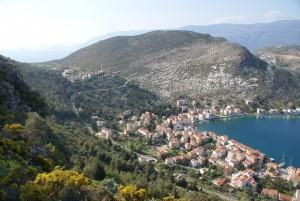Kastelorizo (Island)

Kastelorizo |
Welcome to Kastelorizo!
East of Rhodes, 72 miles away, lies Kastelorizo (also spelled Kastellorizo or Castellorizon), or Megisti (=biggest), a small island of only 8.9 sq. km. (3.44 sq. miles), the furthest eastward Greek island, and inhabited by 430 people (2001 census). It is just 0.77 miles off the Turkish coast, and is of major economic importance, since the island's Exclusive Economic Zone (EEZ) bridges the EEZ of Cyprus to that of Rhodes, thereby creating a unified Grecian-Cypriotic EEZ. This region has suddenly become geo-strategically important due to the huge hydrocarbon gas reserves found there.
Kastelorizo is accompanied by a group of smaller islands and islets: Agios Georgios; Agrielaea; Voutsakia (two islets); Megalo Mavropini and Mikro Mavropini; Polyfados (two islets); Ro; Savoura; Strongyli; Tragonera; Psomi, and Psoradia, together forming a small archipelago designated as the Municipality of Megisti.
The inhabitants of Kastelorizo make their living on (what else?) the sea, and the island has had notable nautical and mercantile growth in the past. It became popular among tourists looking for an isolated place in the Dodecanese, thanks to the 1991 Oscar-winning movie Mediterraneo, which was set on the island. More recently it was chosen to accommodate the meeting of the EU Ministers of Foreign Affairs held at Rhodes and Kastelorizo in May of 2003. Kastelórizo was the only territory of the European Union where the Solar eclipse of 29 March 2006 was visible in its totality. Here, in 2010, the Greek Prime Minister delivered the announcement of the EU-IMF bailout of the Greek economy.
Since most of the above might interest only economists and politicians, we can assure you that there are many other wonderful sights to see and things to do. Just a few include the Castle of the Knights of St. John, after which the island was named (Castello Rosso = Red Castle); Palaeokastro with its Dorian acropolis and its Cyclopic walls; Agios Georgios tou Vouniou (St. George on the mountain) with the St. Charalambos catacomb; a 4th century B.C. Lycian grave; the Archaeological and Folk Art Museum in the preserved old Mosque, with many interesting exhibits; the ruins of a Turkish Bath (Hamam) next to the castle and a restored watermill; the St. Constantine and Helen's Minster, at Mandraki, a domed three-aisled Basilica built in 1835, partially with material taken from the ancient temple of Apollo at Patara of Lycia (in Asia Minor); the ancient tombs at Avlonia high up the mountain; the Blue Cave (Phokiali) with its stalactite decoration; and the islet of Ro. As you can see, for such a small island, there is a lot that one can do and never be bored.
There are no major sandy beaches on the island, but one can have a swim just about anywhere in the crystal-clear water. Small rocks and pebbles should not stop you from enjoying the sea. The best swim you might take, however, is inside the Blue Cave, with its impressive stalactites hanging down from the ceiling of the dome. More recreational activities are diving, scuba diving, sailing and fishing. There's only one town on the island and no major roads, so walking and hiking are not only great activities, but necessities as well. Just enjoy the charm, peace and serenity of the place, one without thundering clubs and discos ... which is probably one of the reasons that you chose this delightful paradise in the first place!
| Kastelorizo: Cities and Towns | | |
| |
|
Megisti

Panoramic View of Kastelorizo, Megisti |
|

View of Kastelorizo |
|

View of Kastelorizo, Megisti |
|

View of Kastelorizo, Megisti |
|

View of Kastelorizo Port |
|

Kastelorizo Blue Cave |
|
| |
|
|



